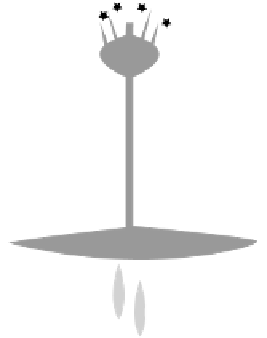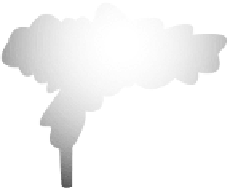Geoscience Reference
In-Depth Information
decompression; they are slowed during their subsequent rise
as
buoyant plumes
(Section 4.20) by boundary layer shear
mixing in
Kelvin-Helmholz vortices
(Section 4.9) and by
upward linear expansion. Plume buoyancy is due to thermal
energy exchange between entrained hot particulates, exsolv-
ing and expanding hot gases, and ingested air. It is the effi-
ciency of the heat exchange, together with the sustained flux
of energy that governs the overall magnitude of the buoyant
plume. Ascent of the buoyant suspension is accompanied by
sedimentation of increasingly finer particulates as the verti-
cal turbulent stresses (Cookies 8 and 13) available in the col-
umn, prove incapable of holding up the clasts. Finally the
plume reaches its limit and spreads laterally as a capping or
umbrella cloud
when its bulk density equals that of the local
atmosphere or stratosphere. By this time, only the finest par-
ticulates remain to be entrained in zonal winds like the jet
streams whereupon they may circumnavigate the globe pro-
viding a temporary but quite efficient reflector of short-
wave solar radiation back to space. Lower-level ash is
gradually “rained-out” or diffuses naturally back to the sur-
face. Various scales and types of eruption column represent
different levels of explosive energy (Fig. 5.30) and are
named after well-known volcanoes, volcanic provinces, or
their first observers, viz. Hawaiian and Strombolian fire
fountains (low level; lava surface gas exsolution), Plinian
(high level; gas-magma frothing, fragmentation), Vulcanian
(intermediate level; sudden unblockage-related gas blasts),
and Surtseyan (intermediate level; external surface water,
vaporization) types. Plinean, Volcanean, and Surtseyan
eruption columns also feature a very characteristic radial
outward blast at the base of the erupting column (Fig. 5.3)
called a
base surge
. These are actually high velocity
wall-jets
(like the turbidity currents featured in Scetion 4.12) and
were first recognized as prominent features in volcanic erup-
tions after close observation of blast behavior during near-
surface nuclear explosions. Base surges range from cool and
wet to hot and dry, depending on the eruption and ambient
mixing characteristics of the flows involved. They are turbu-
lent enough to cut cone-flank channels and to produce
granular bedforms like dunes during deposition. They
Eruptive discharge
out = f (
∆
r)
´Quakes
Dykes
∆
p
Brittle
Upper crustal
magma chamber
overpressured at
∆
r
Melt
discharge in
Plastic
Lower crustal
magma chamber
CRUST
MANTLE
replenishing
magma discharge
Fig. 5.29
Possible arrangement of deep and shallow magma
chambers under an active volcano. The lower crustal details
are largely imaginative. The brittle-ductile zone is at about
400
C.
PhreatoPlinean (<40 km)
Surtseyan (<20 km)
Vulcanian (<20 km)
Plinean (<55 km)
SubPlinean (<30 km)
Strombolian
(<10 km)
Hawaiian
(<2
k
m)
HEIGHT REACHED BY ERUPTIVE UMBRELLA CLOUD
Fig. 5.30
Explosive eruptions according to energy and height of eruptive column.






















































Search WWH ::

Custom Search